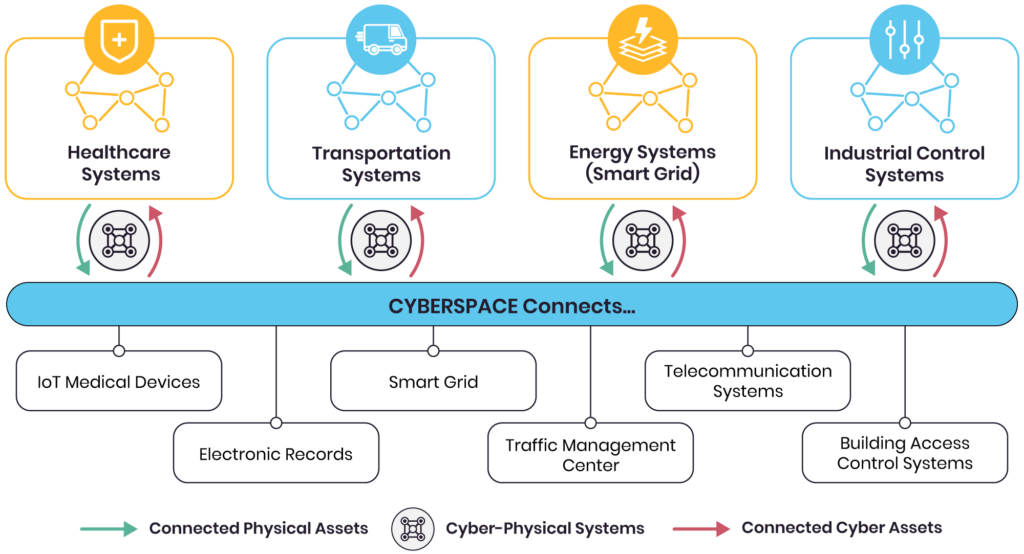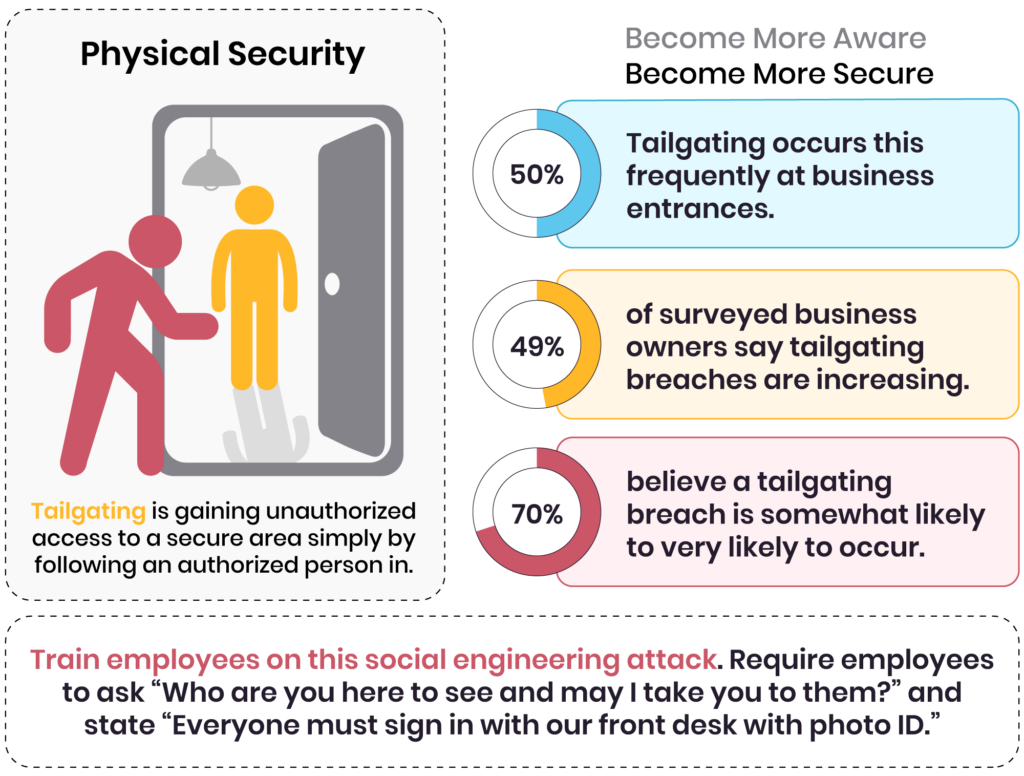Physical Security in Cybersecurity
- Chapter 1: Tutorial & Best Practices
- Chapter 2: Commercial Building Security Systems
- Chapter 3: Physical Security Systems
- Chapter 4: Data Center Physical Security
- Chapter 5: Physical Security Cybersecurity
- Chapter 6: Physical Security Plan
- Chapter 7: Physical Security Controls
- Chapter 8: Retail Security Systems
- Chapter 9: Physical Security Tools
- Chapter 10: Physical Security Program Best Practices
Physical security, personnel security, and information security are all critical elements complementing and supporting cybersecurity. Together, they form a complete defense framework that protects an organization’s digital assets, people, infrastructure, and essential data.
Organizations that neglect any of these elements will be subjected to higher cyber risk and higher risk of a breach. A multi-layered approach (defense-in-depth) is necessary to reduce business risk and protect assets.
The line between physical security and cybersecurity is blurring due to the rise of connected IoT devices, cloud computing, and hybrid work environments. A physical security breach may lead to a cybersecurity breach and vice versa.
For example:
- A compromised surveillance system could give hackers access to the network if not properly secured.
- Physical access to a data center could allow attackers to install recording devices, deploy malware, or steal data.
- Social engineering attacks, like phishing or tailgating (following someone into a secure area), bridge the gap between physical and cyber vulnerabilities.
This article discusses the connection between physical security and cybersecurity, emphasizing how both are crucial for a comprehensive defense strategy in an organization. It also explores the interdependencies between these physical security and cybersecurity elements, highlighting how vulnerabilities in one area can expose an organization to risks in others.
Summary of key physical security cybersecurity concepts
The table below summarizes some fundamental concepts of physical and cyber security that this article will cover in more detail.
| Concept | Description |
|---|---|
| Importance of physical security in cybersecurity | Physical security is a crucial yet often overlooked aspect of cybersecurity. It involves protecting the hardware, software, networks, and data from physical actions or events that could lead to data breaches, system failures, or unauthorized access. |
| Common physical security threats to cybersecurity | Physical security threats to cybersecurity arise when attackers target the physical infrastructure that houses critical digital systems. |
| Key physical security measures in cybersecurity | Physical security measures are essential in safeguarding digital assets and ensuring the overall success of cybersecurity efforts. |
| Best practices for physical security in cybersecurity | To effectively safeguard critical infrastructure, organizations must implement comprehensive physical security measures. |
-

Monitor the health of physical security devices and receive alerts in real-time
-

Automate firmware upgrades, password rotations & certificate management
-

Generate ad hoc and scheduled compliance reports
Importance of physical security in cybersecurity
Physical security and cybersecurity are closely related since they have vital responsibilities in defending operations, data, and assets against potential attacks.

A logical overview of connected cyber-physical systems. (Source)
Physical security is critical to cybersecurity because digital systems are vulnerable to a wide range of threats without proper physical infrastructure protection. Examples of such threats are:
- Eavesdropping on communications: By physically tapping into network cables or unprotected Wi-Fi networks, attackers may be able to eavesdrop on private conversations or intercept network traffic in insecure physical areas.
- Physical sabotage: If an insider or intruder gains access to critical infrastructure, they could purposefully damage servers, erase backups, or interfere with power supply, resulting in interruptions or the loss of vital data.
- Shoulder surfing: Attackers stand directly behind employees or use cameras or other tools to record their activities as they physically watch them input passwords, use secure systems, or handle sensitive data.
8 reasons why physical security in cybersecurity is essential
The sections below detail 8 reasons why physical security is a cornerstone of robust cybersecurity.
Hardware and infrastructure protection are a prerequisite for software security
To paraphrase a common cybersecurity axiom, if a threat actor has access to your systems, they are not your systems. Threat actors can launch a cyberattack by physically accessing critical hardware, such as plugging in harmful devices or using unsecured computers. Organizations must physically secure servers, data centers, and networking equipment to prevent unauthorized access.
Building security is a cornerstone of cybersecurity
Cyber vulnerabilities can arise from physical breaches, such as breaking into a building. An intruder might, for instance, disrupt security measures or gain access to improperly secured systems to steal sensitive data.
Insider threats often exploit physical weaknesses
Insiders, such as workers or contractors, could access both digital and physical systems. Strong physical security measures (such as monitoring, surveillance, and access control) should be implemented to reduce the possibility of insider threats, which might result in internal cyberattacks.
Backup and disaster recovery systems depend on physical security
Organizations should physically protect data backups and systems and store them in separate physical locations to ensure that they are available during disaster recovery efforts or in case of a cyberattack. If backups are physically compromised, recovery from a cyberattack becomes impossible.
OT security keeps physical systems running across multiple industries
Operational technology (OT) is used in many areas, including manufacturing, healthcare, and energy. OT regulates physical processes. Both digital assets and personal safety could be at risk from a cyberattack on OT systems caused by a breach in physical security.
Natural disaster risk mitigation
If data centers and other vital systems are not sufficiently secured, physical damage from natural catastrophes (such as fire, floods, or earthquakes) may jeopardize cybersecurity. Resilience against such occurrences is ensured by appropriate physical protection, preserving the integrity of cyber systems.
Physical access controls reduce sensitive data risk
Limiting physical entry to locations of high risk, like server rooms, ensures that only people with permission can work with the systems. Unauthorized access directly influences cybersecurity because it can result in malware installation, data theft, or system tampering.
Compliance requirements often demand physical security measures
Robust physical security measures are mandated by numerous regulatory frameworks for cybersecurity compliance. Neglecting to safeguard tangible assets may lead to legal ramifications, compromised data, and eroded confidence.
Common physical security threats to cybersecurity
The most frequent physical security risks to cybersecurity are caused by carelessness in protecting physical infrastructure or portable devices, lack of access rules, and human error. Organizations should continuously monitor and reinforce physical security measures to prevent these common physical threats from undermining their cybersecurity initiatives.

Graphic showing statistics related to tailgating incidents which are becoming more frequent (Source)
The following table lists common physical security threats facing organizations, each of which can have significant cybersecurity implications.
| Threat | Description |
|---|---|
| Tailgating | Gaining unauthorized access to a secure area simply by following an authorized person in. |
| Device theft | Sensitive data stored on portable devices such as laptops, smartphones, and USB drives is susceptible to theft. These devices can be used to get access to sensitive data or vital systems if they are not properly encrypted or secured. |
| Unauthorized physical access | Personnel, independent contractors, or other unauthorized persons having entry to vital infrastructure may take advantage of their rights to steal confidential information, install malicious software, or disrupt systems. |
| Social engineering and impersonation | Social engineering techniques, including posing as contractors or IT staff, can be used by attackers to enter restricted areas. Once inside, they can steal confidential data or physically compromise devices. |
| Lack of surveillance and monitoring | Sensitive places can be freely walked by unauthorized individuals or attackers due to inadequate physical space surveillance. Without motion detectors, access logs, or CCTV cameras, organizations might not be aware of a breach until it’s too late. |
| Inadequate hardware disposal | Dumpster diving or improper disposal of old hard drives, network equipment, or printed materials is a frequent issue. Attackers can retrieve sensitive data from discarded hardware that hasn’t been properly wiped or destroyed. |
Nine practical physical security measures for cybersecurity
In the modern cybersecurity landscape, physical security measures play an essential role in protecting digital assets and infrastructure. While cybersecurity is often thought of as purely digital, the physical protection of critical systems, data centers, devices, and personnel is equally crucial. A failure in physical security can easily translate into a vulnerability in cybersecurity, as unauthorized access to servers, workstations, or even portable devices can lead to data breaches, theft, and malicious activities.
From access control systems to environmental monitoring, organizations must adopt robust physical security protocols to complement their cybersecurity defenses and ensure a multi-layered approach to risk mitigation. Below are nine of the most important physical security measures for robust cybersecurity.
Surveillance and access control systems
Organizations should enable continuous monitoring of physical spaces to deter unauthorized access and provide a record of physical activities around sensitive areas. Surveillance can be useful in forensic investigations after a security breach. Solutions like Securithings’ IoTOps platform provide advanced monitoring and management of connected security devices, ensuring they function correctly and are secure from tampering or cyber threats. Confirming that only authorized workers can access critical places, like server rooms or data centers, is ensured by the use of electronic access control systems.
Securithings’ services also help maintain compliance and security of physical security systems, such as access control and surveillance. Restrict physical access according to role requirements to keep unauthorized individuals out of key locations. This seamlessly adds Securithings as a relevant player in the physical security and IoT monitoring space.
Radiofrequency identification (RFID) systems have become crucial to physical security in many organizations. RFID badges or keycards are equipped with unique identifiers, allowing companies to log entry attempts and track the movement of individuals across secure locations. However, you should ensure that these systems are tamper-proof and encrypted, which is essential to prevent cloning or unauthorized access.
Moreover, two-factor authentication (2FA) enhances security by requiring both a physical factor (e.g., a keycard or biometric scan) and a digital factor (e.g., a password or authentication app) to access restricted areas. This approach combines physical security with cybersecurity, ensuring that even if one method is compromised, unauthorized access is still prevented, e.g., an organization uses a keycard (something you have) combined with a one-time passcode from an authentication app (something you know) for employees to access high-security areas, ensuring a robust defense against unauthorized entry.
Security guards and personnel
Every organization with physical infrastructure needs staff members trained to respond quickly to suspicious activity or unauthorized entry in addition to acting as a physical deterrent. To detect possible physical security breaches, such as doors left open or tampered equipment, frequent patrols should also be conducted.
Physical barriers
Barriers, such as gates, bollards, and fences, must be installed to keep unauthorized people out of critical locations and off secure property. Implementing a layered security approach ensures that sensitive locations have multiple levels of protection, with external barriers like fences or gates complemented by additional internal measures such as locked enclosures, security checkpoints, and reinforced doors for server rooms. Server racks, network devices, and sensitive equipment should also be housed in locked enclosures, creating an added layer of physical defense to deter potential intruders from gaining direct access to critical infrastructure.
Environmental controls
Every organization should install fire suppression systems. Protecting against potential fire damage that could destroy critical infrastructure like servers and data storage systems is crucial. Organizations should also ensure that server rooms and data centers are maintained in ideal operational conditions to avoid equipment failures. Additionally, uninterruptible power supplies (UPS) and generators safeguard systems from power outages, preventing data loss and downtime.
Secure hardware disposal
To prevent potential data recovery, you should make sure that outdated gear, such as hard drives and storage devices, is physically destroyed or securely erased. Methods for secure erasure include software-based solutions like data wiping, where specialized programs overwrite the data multiple times to ensure it cannot be recovered. Tools like DBAN (Darik’s Boot and Nuke) or Blancco Drive Eraser are commonly used for this purpose. For SSDs, which have different data storage mechanisms, techniques like Secure Erase commands or cryptographic erasure (where encryption keys are destroyed) are recommended. When physical destruction is necessary, techniques like degaussing (disrupting magnetic fields on hard drives) or shredding the drives into small pieces ensure data is irrecoverable. To avoid dumpster diving, dispose of sensitive printed papers in locked shredder bins.
Alarms and intrusion detection systems
Set up alerts to notify security staff of any unauthorized access to server rooms or other vital areas. Keep an eye on activities in vulnerable places and sound the sirens when something unexpected happens after hours.
Physical locks and Keys
Put high-security locks on cabinets, doors, and rooms that contain sensitive IT equipment. Physical keys should be strictly controlled to prevent unauthorized use or copying. While IoT and Bluetooth locks may offer convenience, they introduce additional cybersecurity vulnerabilities. These locks are susceptible to hacking via Bluetooth signals, device spoofing, or network vulnerabilities, potentially allowing unauthorized access if compromised.
Unlike traditional mechanical locks, which require physical presence to breach, IoT locks can be attacked remotely, making them less secure for environments where sensitive IT equipment is stored. As a result, traditional, high-security mechanical locks or network-isolated smart locks are often more secure choices for protecting critical infrastructure.
Smart locks provide an advanced layer of access control by using digital credentials such as PIN codes, mobile apps, or biometric data for entry. These systems reduce the risks associated with traditional keys, which can be lost, stolen, or duplicated. You should integrate Smart locks with centralized security systems, allowing real-time monitoring and remote locking or unlocking.
Visitor management systems
Make visitors check in with security and wear badges of identification while they are on the property. This guarantees that every guest is monitored and escorted as needed. Keep a record of every person who enters restricted locations, including contractors, workers, and guests.
AI-enhanced surveillance systems
Artificial intelligence has revolutionized surveillance by automating the detection of suspicious activities. AI-enhanced surveillance systems can continuously monitor live camera feeds and detect anomalies that might go unnoticed by human operators. You should program these systems in such a way to identify specific behaviors, such as loitering, forced entry attempts, or even unauthorized access to sensitive areas.
AI and facial recognition systems can automate tailgating detection by analyzing who enters a facility and whether the individuals entering match the authorized profiles. Facial recognition technology can track who has been given access and flag if an unauthorized person follows behind without proper credentials.
For example, a corporate building equipped with facial recognition at entry points can automatically flag instances where two people pass through using one authorized individual’s credentials. The system can notify security personnel or trigger automated barriers to prevent unauthorized entry.
Best practices for physical security in cybersecurity
Conducting thorough risk assessments to identify vulnerabilities, training staff on security procedures, implementing layered security to provide multiple lines of defense, and making sure that ongoing monitoring and auditing are in place to identify and address potential threats in real-time are some of the key best practices in physical security for cybersecurity.
By strengthening physical defenses and enhancing cybersecurity initiatives, these practices provide a comprehensive, integrated security plan that safeguards both digital and physical assets. Each physical security best practice is clearly outlined in the table below, along with real-world examples of how it can be used.
| Best practice | Description | Example |
|---|---|---|
| Conduct risk assessments | Evaluate regularly physical security threats to identify vulnerabilities. | A data center identifies its lack of fire suppression systems, leading to the installation of gas-based fire suppression. |
| Train employees | Educate staff on physical security protocols to prevent security breaches. | Employees are trained on “tailgating” prevention, ensuring that no unauthorized individuals follow them into secure areas. |
| Use defense-in-depth principles for robust security | Use multiple, overlapping security measures to provide comprehensive protection. | A corporate office combines perimeter fencing, biometric access controls, CCTV cameras, and locked server racks for maximum security. |
| Continuously monitor and audit | Track security systems and regular assessments of their effectiveness. | CCTV systems monitor critical areas 24/7, while monthly audits ensure access control systems are functioning properly. |
| Practice patch management | Apply regular updates and patches to software and hardware to address security vulnerabilities and improve system performance. | A company implements an automated patch management system that regularly updates the firmware on their network routers and applies security patches to their operating systems to prevent known vulnerabilities from being exploited. |
| Use strong access controls | Implement mechanisms to ensure that only authorized individuals have access to sensitive areas or data, reducing the risk of breaches. | A financial institution uses biometric scanners and keycard systems to restrict access to their data center, ensuring only employees with the proper clearance can enter. |
| Implement a physical security management platform | SecuriThings offers an IoT management platform designed to enhance the security of connected devices by ensuring they are monitored, managed, and updated consistently. It helps organizations maintain compliance with security standards and provides visibility into the security posture of IoT devices across the enterprise. | A smart building uses SecuriThings’ platform to monitor and manage its connected security cameras and access control systems. The platform automates firmware updates, ensures devices are securely configured, and provides alerts for any suspicious activity or vulnerabilities detected in the system. |
| Converge physical security and cybersecurity | Encrypt and protect biometric data, collected for physical access control or identity verification, both during transmission (in transit) and when stored (at rest). This convergence of physical and digital security ensures that sensitive data is not vulnerable to cyberattacks or breaches. | A company using fingerprint scanners for access control encrypts the biometric data both when it is transmitted from the scanner to the database and when stored on the server, ensuring the data is secure from unauthorized access and cyber threats. |
Conclusion
Physical security is the foundation of cybersecurity. Without it, physical access can quickly compromise digital safeguards, making even the most sophisticated cybersecurity precautions worthless. For this reason, to safeguard their assets, organizations need to take a holistic approach that incorporates both physical and cyber defenses.
Physical security and cybersecurity must work together in an integrated approach to prevent and respond to threats effectively. As technology continues to evolve, the need for this collaboration will only increase, making it essential to have a comprehensive understanding of both areas for an effective security strategy.


